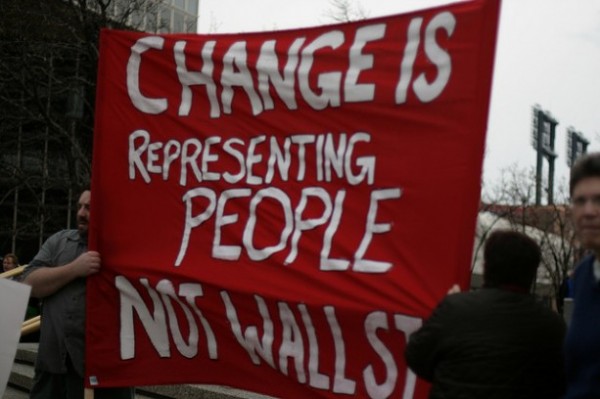
For the first time, California’s citizens are taking charge of the redistricting process, which determines the boundaries of the state’s political districts. The Citizens Redistricting Commission’s draft maps, which were released June 10, are up for public review and will be certified in August. Although many are optimistic about this experiment, others wonder whether redistricting can truly change California’s political landscape. In advance of a panel about whether redistricting will improve California, we asked experts whether new political boundaries will make any difference for regular people.
Competitive Elections Will Produce More Confidence in the System

Redistricting affects constituents in a number of important ways. Perhaps the most important effect of redistricting is that it lays the foundation for whether a given district will have competitive elections. Research tells us that competitive elections tend to encourage representatives to be more responsive to their constituents, which is an essential component of a healthy representative democracy.
Competitive elections also result in higher voter turnout and generate more public dialogue about issues facing society. Redistricting also influences the types of candidates who run in elections and therefore the choices that constituents have.
We have seen instances throughout our country’s history where redistricting schemes have marginalized minority groups and disfavored one party or the other. To the extent this does not happen, constituents will feel that their vote and political views matter.
Another important factor in whether redistricting affects constituents is whether the public has confidence in the redistricting process itself. The partisan gerrymander that characterized the 2001 process fed the public’s cynicism towards our governmental system and elected leaders. The new redistricting commission should help insulate the process from political manipulation and instill more integrity in the redistricting process. This should, in turn, strengthen the public’s confidence in the political system.
Jeffrey Cummins is a political scientist at California State University, Fresno. His teaching and research areas focus on American politics and public policy.
—————————————————————————————————————
It Won’t–Unless You’re a Government Employee or Felon

The pithy answer is: not much.
Redistricting affects incumbent politicians immediately; they now must run for reelection amongst unfamiliar voters. While this makes incumbents somewhat less safe, it scares them and makes them raise more money and campaign harder. And they won all these previous elections for a reason: they’re good at it. However, for two groups of incumbents, of either party, the repercussions are more dire: incumbents paired into districts together and incumbents who now live in a district almost certain to go to the opposing party are certain (or close to certain) to lose.
Redistricting also affects potential candidates. Mayors, state assemblymen or any potential entrant who had been thinking of running now have new lines. This may be good, if it puts your “natural voters” into your district, or bad, if those “natural voters” are now in your neighboring district.
How will redistricting affect constituents’ lives, though? Californians are still going to be represented at all levels by someone who represents a large number of people. Both Republicans and Democrats will help their constituents with ombudsman-like services. The “visualizations” released so far suggest Democratic gains generally. Nationally, Democrats stand to lose a few seats due to redistricting, despite pickups in California. In the state legislature, it remains to be seen if these potential gains will materialize or be enough to get to a two-thirds majority for the Democrats. That might affect constituents: tax rates, office hours at government offices, prison inmate releases, and state services like education would be likely to change. But, at the end of the day, “government is a sideshow in the circus of life.” Unless they’re a government employee or felon, most of those changes are likely to be fairly minor in the grand scheme of things for most people.
Matthew G. Jarvis is a political scientist at California State University, Fullerton. He has published articles on voting technology and his research interests include congressional elections, veto politics, and campaign finance.
—————————————————————————————————————
Distribution of Political Power Could Shift

Ask the average person on the street how she feels about redistricting, and the answer is likely to be: “huh?” Most people are unaware of what redistricting is, and a description of the Rube Goldberg machine created by Proposition 11 that produced the redistricting commission that produced the maps is likely to cause more eyes to glaze over.
The process of drawing district lines does matter to constituents, whether they are aware of it or not. Redistricting determines whether races for Congress and the state legislature will be competitive or not; whether minority voters will get a fair opportunity to elect candidates of their choice; and how much power each political party will have in government.
Before Prop. 11, the redistricting process in California was left to politicians. When they could, they drew districts to protect themselves from competition and to promote their party. When they could not agree (as when there was a Democratic legislature and a Republican government), the courts came in and drew the plans.
Now, with Prop. 11, we are embarking on a new experiment to see what a group of citizens can do if given the task to draw district lines. Whatever the Commission decides, some people will grumble, and any plan the Commission comes up with will almost certainly be challenged by someone in court.
This is a high-stakes issue for political insiders. And while the public might think that drawing district maps is about as exciting as watching paint dry, in fact the decision could affect the distribution of political power in California and even Congress for the next decade.
Richard L. Hasen is a visiting professor at UC Irvine School of Law and a William H. Hannon Distinguished Professor of Law at Loyola Law School. He co-authored Election Law, Fourth Edition and writes for his blog electionlawblog.org.
—————————————————————————————————————
Like Past Reforms, It Won’t Work the Way Voters Intended

The core principle of democracy is that the voters choose their elected officials. In California these days, developments in redistricting technology and practice has made it so that elected officials choose their voters instead. The disturbing result has been a near total absence of competitive state legislative districts on Election Day. So it’s easy to understand why Californians supported the ballot proposition giving a citizens commission the power to draw district lines.
Don’t be surprised, however, if the new method of legislative districting doesn’t do much to improve California voters’ unhappiness with politics.
Californians have a long history of populist-inspired reform. In 1911, the state constitution was amended to create the ballot initiative process, enabling voters to directly enact legislation without having to go through the legislature, which was thought to be under the thumb of railroad companies. In 1990, Californians used this mechanism of direct democracy to institute term limits to lessen the power of incumbency and once again return power to the people.
These structural reform efforts have been undermined by unintended consequences. The millions of dollars it takes to get a measure on the ballot and then run a campaign makes direct democracy a valuable resource for moneyed interests. Term limits, meanwhile, have shifted power away from the legislative branch and towards administrative agencies, as inexperienced lawmakers are forced to rely on the greater expertise of relatively unaccountable bureaucrats. That Californians are still seeking major changes to the political system–like citizen-based districting–indicates that those previous efforts haven’t had their desired effect. And that’s the rub for California’s latest populist reform. Whether or not the citizens commission really empowers voters will depend largely on a set of consequences that no one can reliably predict. The only sure thing is that the new districting process won’t work the way voters intended.
Adam Winkler is professor of law at University of California at Los Angeles School of Law. He is currently writing a book on guns and the right to bear arms.
—————————————————————————————————————
Ideally, Communities Of Interest Will Be Better Served

Redistricting will affect constituents in ways that impact their quality of life and their position as members of a democratic society structured to serve their preferred political, economic and cultural interests. The redrawing of district lines is an area of political decision-making that has allowed governors, state legislatures and local officeholders to exercise their influence by drawing politically and personally advantageous districts rather than those that are in constituents’ best interests. Lines drawn as partisan and/or personal safe districts are susceptible to negative impacts on constituents who share common interests around, for example, distribution of school taxes or environmental sustainability policies.
For redistricting to affect constituents positively, district lines should be based on criteria that facilitate fair representation like “communities-of-interest.” Definitive definitions of communities-of-interests are elusive, ranging anywhere from economic to ethnic commonalities, but acquiesce in the communities-of-interest direction by drafters of district lines will be superior to lines drawn on partisan or personal considerations. Contiguous and geographical considerations are embedded in communities-of-interest consideration because populations of like interest tend to be near one another.
Generally, representatives from districts drawn with a majority or dominant community interest in mind will be responsive and sensitive to the constituent’s when advancing and/or supporting legislation, whether or not it corresponds to their partisan or personal preferences. Representatives elected and/or re-elected in districts drawn on a community-of-interest basis and then drift away from their constituent’s wishes risk defeat in the next election. As the size of a community-of-interest population (such as working class or environmental sustainability) increases, the probability that a candidate sensitive to those interests will be elected also increases. However, healthy voter turnout for elections is critical to making this work. Carefully drawn lines with the constituent’s interests as the primary objective enhances fairness in political representation and the one-person-one-vote philosophy.
Gregory Freeland is a political scientist at California Lutheran University specializing in American and comparative politics.
—————————————————————————————————————
Ethnic Politics May Prevent True Change

My short answer is “it depends, but the outcome of redistricting could be dramatic, and while it is likely to improve the districts over the current ones, it is not likely to improve them as much as it could.” All right, that’s not so short.
It depends, obviously, because until the Citizens Redistricting Commission (CRC) releases its proposed districts, and they are modified or accepted or rejected, who can say confidently what the influence of the new districts will be? It could be dramatic, because the location of electoral district boundaries can have such a profound influence on who gets elected (in election systems like ours). It is likely to result in improved districts, because almost any change to redistricting that takes it away from partisan legislators is likely to produce more democratic and competitive districts–one of California’s most critical needs, in my opinion. Having partisan legislators make their own districts is way too much like having the fox watch the hen house (and it’s fairly unusual for democratic electoral systems elsewhere in the world).
That said, I suspect the current redistricting effort may not improve our districts as much as it could because of various pressures that will likely distract the CRC from producing optimally competitive and balanced districts. Besides the standard partisan pressures that continually beset what is supposed to be an independent process, the pressures to “represent” particular ethnic and racial groups in the way districts are drawn is exaggerated in California. The intent of the Voting Rights Act is just (especially considering our country’s history) and approximate ethnic and racial representativeness seems appropriate, but partisan competitiveness and competent representation are most essential in the end, whatever the ethnicity of the elected official. The notion that a Chinese American, for instance, has to vote for a Chinese-American candidate or that her best interests are necessarily served by a Chinese-American representative seems wrong and even insulting.
Daniel R. Montello is a psychologist and geographer at the University of California, Santa Barbara. Montello has edited several books and is the co-author of An Introduction to Scientific Research Methods in Geography.
—————————————————————————————————————
Minority Communities Will Get Better Representation

Redistricting affects the quality of your elected representation. If your community is placed in a district whose other residents have dramatically different needs and concerns, then the needs and concerns of your community have to compete for the attention of the district’s representative. In contrast, where populations share common interests and needs, known as “communities of interest,” are grouped in the same district, the district’s representative can devote more attention to, and thus be more responsive to, those shared interests and needs.
Redistricting also affects the ability of racial minority populations to elect preferred candidates of choice. Although led by an African-American president, our nation still has not entered a “post-racial” era as some may believe. In many areas of the country, including some parts of California, candidates preferred by minority voters still do not receive support from non-minority voters.
Where these patterns of racially polarized voting persist, minority voters, by definition, will tend to see their preferred candidates consistently defeated election after election, unless they are placed in districts where they constitute a majority or near-majority of the district’s population. In certain instances, federal civil rights legislation (the Voting Rights Act of 1965) requires such “majority-minority” districts to be drawn, thereby providing racial minorities with an equal opportunity to elect their preferred candidates despite the persistence of racially polarized voting.
On June 10, the California Citizens Redistricting Commission released draft maps for new state and federal districts. These maps can be looked at through multiple lenses, but the two impacts described above are particularly important to ask questions about–how well do the maps promote quality representation for one’s community and how well do they comply with federal laws protecting the civil rights of racial minorities?
Eugene Lee is Voting Rights Project Director at the Asian Pacific American Legal Center, which advocates for civil rights, provides legal services and education and builds coalitions to positively influence and impact Asian Pacific Americans.
—————————————————————————————————————
Lack of Time and Funding Will Produce Shallow Results

In 2000 and 2001, I served as the vice-chair of the San Diego City Council Redistricting Commission–for the first time in the city’s history, an independent commission was established that had the sole authority to create the new districts–and that experience might shed some light on what could happen with this year’s state redistricting process. In the end, our San Diego plan was seen as excellent and fair and there were no lawsuits or referendums to challenge the districts. In my opinion, however, the redistricting plan we created did not differ all that much from previous redistricting plans because of the constraints–a lack of time and funding–faced by the commission.
My concern for the state redistricting is that if the commissioners face similar constraints, they may not be able to engage in the kind of in-depth analysis and discussion that can take advantage of the commissioners’ skills and experience to produce an independent and well-researched plan. Also, while I understand the reasons why voters wanted to place congressional redistricting under the commission this year, I wonder if that extra task is going to hamper efforts by adding to the already complex job of redistricting, exacerbated by the unforeseen problems of implementing the first independent commission.
One basic issue is that neighborhoods are extremely diverse in terms of factors such as economic background, race, issues considered important to residents, etc. There is not one “correct” or “best” way to create a map, but many different ways based on how factors are analyzed and balanced to meet redistricting criteria. For example, there are many areas in the state in which racial minorities share the same neighborhoods and/or live in adjacent communities. When should these groups be separated or placed in the same district? Or, what happens when residents supply conflicting public testimony about what constitutes a community of interest in their neighborhoods?
From my perspective, here are some of the constraints we faced in San Diego and what the state commissioners might consider:
How do the commissioners take into consideration the Voting Rights Act and the protection of minority interests, while also considering the number of Supreme Court decisions which have limited the use of race in redistricting? In the San Diego case, we had one city attorney advising us. Professional and conscientious, she worked hard to supply us with information and analysis. But as a city employee, I believe that one of her major duties was to protect the city from a lawsuit. It would have been useful to have input from an independent attorney(s) to get additional analysis.
Also, to consider the interests of groups normally disenfranchised by politics and redistricting, such as those that are low income, immigrants and racial minorities, additional analysis looking at legal, political and other factors would have been useful.
We had in-house staff helping us with the mapping software and outside consultants to help us consider the range of criteria we had to consider. I felt that we needed more time and funds to do more analysis and research.
Public testimony is a crucial way for understanding communities of interest and we held more than 50 public meetings–many more than was required–because we wanted to hear from residents, especially those who ordinarily did not participate in the redistricting process. Regarding the latter group, this did not happen. In my opinion, we were naïve to think that those that are usually excluded or disenfranchised by politics would suddenly feel included and empowered and attend the hearings. Again, this places added weight on the analysis of data that can examine the situation of those that are often ignored or disenfranchised by redistricting.
Leland Saito is a sociologist at the University of Southern California. He is the author of The Politics of Exclusion: The Failure of Race-Neutral Policies In Urban America.
*Photo courtesy of tolkien1914.



